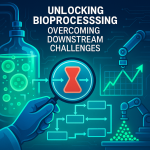⚙️ Traditional methods struggle with separating useful viral vectors from impurities.
🔬 A new approach using mass photometry can distinguish full and empty particles without purification.
⏱️ This innovation can speed up manufacturing and reduce costs, enhancing gene therapy’s industrial viability.
💡 It’s a promising step towards efficient gene therapy production.
Introduction:
The advancement of gene therapy is becoming increasingly pivotal in modern medicine, promising effective treatments for various ailments through the use of recombinant adeno-associated viruses (rAAVs) as delivery vectors. However, the industry faces significant challenges in scaling up manufacturing processes efficiently without sacrificing quality.
- Gene therapy is rapidly evolving, with numerous FDA-approved treatments and ongoing clinical trials, leading to a pressing need for scalable manufacturing solutions.
- Current production methods of rAAVs often yield a mixture of therapeutic (full capsids) and non-therapeutic (empty capsids) particles, necessitating time-consuming purification processes to isolate the beneficial particles.
- Traditional analytical methods to assess the full-to-empty particle ratio (F/E ratio) during production are burdensome, often requiring sample purification and reference standards.
- A novel study from the University of Osaka proposes mass photometry, a label-free technique, as a viable alternative for measuring rAAV quality directly in unpurified samples.
- This method enhances manufacturing efficiency by rapidly determining the F/E ratio and estimating the genomic titer, thus streamlining the production process without the need for extensive purification steps.
Conclusion:
The introduction of mass photometry as a real-time analysis tool marks a significant leap forward in gene therapy manufacturing. This method not only accelerates production but also ensures consistent quality control, vital for advancing the clinical application of gene therapy. As the field continues to grow, innovations like mass photometry may prove essential for making gene therapies more accessible and cost-effective.



